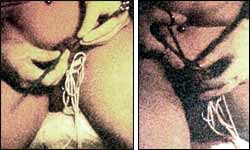Excess Hair and Exsanguinate: Difference between pages
(Page conversion via llm-mediawiki-rev -jwm) |
(Page conversion via llm-mediawiki-rev -jwm) |
||
| Line 1: | Line 1: | ||
[[File:Exsanguinate-1.jpg|thumb|right|250px]] | |||
To '''exsanguinate''' something is to drain it of [[Blood|blood]]. In the context of amateur home surgery, this may be done for two main reasons — first, it causes a large reduction in perceived [[Pain|pain]] levels (for some people quite if they're working on themselves), and second, it makes for a bloodless (or at least ''less blood'' procedure), thereby making it easier and safer to work. | |||
While this might be used in procedures like home [[Amputation|amputation]], it is more commonly used during simpler procedures such as [[Subincision|subincision]]. It is achieved by wrapping cord or fabric like a tensor bandage around the end/top of the penis, and wrapping down to the base, squeezing out much of the blood. A tie (or [[Zipser Clamp|Zipser clamp]]) is left around the base to keep blood from returning to the penis. It is important to note that your body needs blood to survive, so you can't do this for too long. In addition, don't forget that once you've released the tie at the base, blood will return full force and will flow out of any wounds you've created. | |||
== See Also == | |||
* [[Zipser Clamp|Zipser Clamp]] | |||
* [[Subincision|Subincision]] | |||
* [[Elastration|Elastration]] | |||
Latest revision as of 03:26, 17 September 2023
To exsanguinate something is to drain it of blood. In the context of amateur home surgery, this may be done for two main reasons — first, it causes a large reduction in perceived pain levels (for some people quite if they're working on themselves), and second, it makes for a bloodless (or at least less blood procedure), thereby making it easier and safer to work.
While this might be used in procedures like home amputation, it is more commonly used during simpler procedures such as subincision. It is achieved by wrapping cord or fabric like a tensor bandage around the end/top of the penis, and wrapping down to the base, squeezing out much of the blood. A tie (or Zipser clamp) is left around the base to keep blood from returning to the penis. It is important to note that your body needs blood to survive, so you can't do this for too long. In addition, don't forget that once you've released the tie at the base, blood will return full force and will flow out of any wounds you've created.
